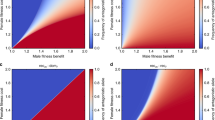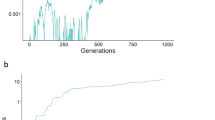Abstract
Natural populations are normally exposed to substantial environmental stress. In these circumstances, an association occurs between success in mating and extremes of sexual ornaments, rapid development, long life span, and low fluctuating morphological asymmetry. This association between important fitness traits depends on high metabolic efficiency underlain by genes for stress resistance and heterozygous advantage. In particular, the high energy demands from the development and maintenance of sexual ornaments imply that the “good genes” favored in the sexual selection process should be stress resistant. However, the generalized heterozygous advantage under stress suggests that many interacting genes are involved in promoting metabolic efficiency, so that the “good genes” approach should be replaced by a “good genotypes” approach. This “good genotype” approach has predictive power for incorporating additional fitness traits, especially where metabolic consequences can be perceived.
Similar content being viewed by others
REFERENCES
Allendorf, F. W., and Leary, R. F. (1986). Heterozygosity and fitness in natural populations of animals. In Soule, M. E. (ed.), Conservation Biology,Sinauer Associates, Sunderland, MA, pp. 57-76.
Anderson, W. W., Levine, L. Olivera, O., Powell, J. R., de la Rosa, M. E., Salceda, V. M., Gaso, M, L, and Guzman, J. (1979). Evidence for selection by male mating success in natural populations of Drosophila pseudoobsura. Proc. Nail. Acad. Set. USA 76:1519-1523.
Andersson, M. (1994). Sexual Selection,Princeton University Press, Princeton, NJ.
Belyaev, D. K., and Borodin, P. M. (1982). The influence of stress on variation and its role in evolution. Biol. Zbl100: 705-714.
Bennett, A. F. (1991). The evolution of activity capacity. J, Exp. Biol. 160:1-23.
Berry, R. J. (1996). Environmental stress and evolutionary adaptation. In Bittlcs, A. H., and Parsons, P. A. (eds.), Stress: Evolutionary, Biosocial and Clinical Perspectives,Gallon Institute and Macmillan, London.
Berry, R. J., and Bradshaw, A. D. (1991). Genes in the real world. In Berry, R. J., Crawford, T. S., and Hewitt, G. M. (eds.), Genes in Ecology,Blackwell Scientific, Oxford.
Boake, C. R. B. (1986). A method for testing adaptive hypotheses for mate choice. Am. Nat.127:654-666.
Brittnacher, J. C. (1981). Genetic variation and genetic load due to the male reproductive component of fitness in Drosophila Genetics 97:719-730.
Brown, J. H., Marquet, P. A., and Taper, M. L. (1993). Evolution of body size: Consequences of an energetic definition of fitness. Am. Nat.142:373-384.
Clarke, G. M. (1995). Relationships between developmental stability and fitness: Applications for conservation biology. Conserv. Biol.9:18-24.
Cordero, A. (1995). Correlates of male mating success in two natural populations of the damsclfly Ischnura graellsii (Odonata: Coenagrionidae). Ecol. Eatomol.20:213-222.
Fisher, R. A. (1930). The Genetical Theory of Natural Selection,Clarendon Press, Oxford.
Fitzsimmons, N. N., Buskirk, S. W., and Smith, M. H. (1995). Population history, genetic variability, and horn growth in bighorn sheep. Conserv. Biol.9:314-323.
Fulker, D. W. (1966). Mating speed in Drosophila mclanogaster: a psychogenetic analysis. Science133:203-205.
Garrett, L. (1994). The Coming Plague: Newly Emerging Diseases in a world out of Balance, Virago Press, London.
Hamilton, W. D., and Zuk, M. (1982). Heritable true fitness and bright birds: A role for parasites? Science218:384-387.
Harvey, I. F., and Walsh, K. J. (1993). Fluctuating asymmetry and lifetime mating success are correlated in males of the damselfly Coenagrion puella (Odonata: Coenagrionidae). Ecol. Entomol.18:198-202.
Hawkins, A. J. S., Bayne, B. L., and Day, A. J. (1986) Protein turnover, physiological energetics and heterozygosity in the bivalve mussel, Mytilus edulis: The basis of variable age-specific growth. Proc. Roy. Soc. Land. B229:161-176.
Hoffmann, A. A., and Parsons, P. A. (1989). An integrated approach to environmental stress tolerance and life-history variation. Desiccation tolerance in Drosophila. Biol. J. Linn. Soc. 37:117-136.
Hoffmann, A. A., and Parsons, P. A. (1991). Evolutionary Genetics and Environmental Stress, Oxford University Press, Oxford.
Hoffmann, A. A., and Parsons, P. A. (1993). Selection for adult desiccation resistance in Drosophila melanogaster. Fitness components, larval resistance and stress correlations. Biol. J. Linn. Soc. 48:43-54.
Hogg, J. T. (1987). Intrasexual competition and mate choice in Rocky Mountain bighorn sheep. Ethology75:119-144.
Kodrick-Brown, A., and Brown, J. H. (1984). Truth in advertising: The kinds of traits favored by sexual selection. Am. Nat. 124:309-323.
Koehn, R. K., and Bayne, B. L. (1989). Towards a physiological and genetical understanding of the stress response. Biol. J. Linn. Soc.37:157-171.
Lithgow, G. J., White, T. M., Melov, S., and Johnson, T. E. (1995). Thcrmotolerance and extended life-span conferred by single-gene mutations and induced by thermal stress. Proc. Natl. Acad. Set. USA92:7540-7544.
Lynch, C. B. (1992). Clinal variation in cold adaptation in Mus domesticus: Verification of predictions from laboratory populations. Am. Nat.139:1219-1236.
Milton, J. B. (1993a). Enzyme heterozygosity, metabolism, and developmental variability. Genetica89:47-63.
Mitton, J. B. (1993b). Theory and data pertinent to the relationship between heterozygosity and fitness. In Thomhill, N. W. (ed.), The Natural History of Inbreeding and Outbreeding. Theoretical and Empirical Perspectives, University of Chicago Press, Chicago, pp. 17-41.
Mitton, J. B., and Grant, M. C. (1984). Associations among protein heterozygosity, growth rate, and developmental homeostasis. Annu. Rev. Ecol. Syst.15:479-489.
Mailer, A. P. (1994). Male ornament size as a reliable cue to enhanced offspring viability in the barn swallow. Proc. Natl Acad. Sci. USA 91:6929-6932.
Moore, A. J. (1994). Genetic evidence for the "good genes" process of sexual selection. Behav. Ecol. Sociobiol. 35: 235-241.
Muller, G., and Ward, P. I. (1995). Parasitism and heterozygosity influence the secondary sexual characters of the European minnow, Phoxinus phoxinus (L:) (Cyprinidae). Ethology100:309-319.
Naugler, C. T., and Leech, S. M. (1994). Fluctuating asymmetry and survival ability in the forest tent caterpillar moth Malacosoma disstria: Implications for pest management. Entomol. Exp. Appl.70:295-298.
Nevo, E. (1991). Evolutionary theory and processes of active speciation and adaptive radiation in subterranean mole rats, Spalax ehrenbergi superspecies, in Israel. Evot. Biol.25:1-125.
Nevo, E., Simson, S., Heth, G., and Beiles, A. (1992). Adaptive pacifistic behavior in subterranean mole rats in the Sahara desert, contrasting to and originating from polymorphic aggression in Israeli species. Behavior123:71-76.
Nevo, E., Filippueci, M. G., and Beiles, A. (1994). Genetic polymorphisms in subterranean mammals (Spalax ehrenbergi superspecies) in the Near East revisited: Patterns and theory. Heredity72:465-487.
Nilsson, J.-A. (1994). Energetic stress and the degree of fluctuating asymmetry: Implications for a long-lasting honest signal. Evol. Ecol.8:248-255.
Norris, K. (1993). Heritable variation in a plumage indicator of viability in male great tits Pants major. Nature362: 537-539.
Parsons, P. A. (1974). Male mating speed as a component of fitness in Drosophila. Behav. Genet.4:395-404.
Parsons, P. A. (1980a). Adaptive strategies in natural populations of Drosophila: Ethanol tolerances, desiccation resistance, and development times in climatically optimal and extreme environments. Theor, Appl. Genet.57:257-266.
Parsons, P. A. (1980b). Isofemale strains and evolutionary strategies in natural populations. Evol. Biot.13:175-217.
Parsons, P. A. (1988). Behavior, stress and variability. Behav. Genet. 18:293-308.
Parsons, P. A. (1990). Fluctuating asymmetry: An epigeneric measure of stress. Biol. Rev.65:131-145.
Parsons, P. A. (1993). Evolutionary adaptation and stress: Energy budgets and habitats preferred. Behav. Genet.23: 231-238.
Parsons, P. A. (1994). Habitats, stress and evolutionary rates. J. Evol. Biol.7:387-397.
Parsons, P. A. (1995a). Stress and limits to adaptation: Sexual ornaments. J. Evol. Biol.8:455-461.
Parsons, P. A, (1995b). Inherited stress resistance and longevity: A stress theory of ageing. Heredity75:216-221.
Parsons, P. A. (1996a). Stress, resources, energy balances and evolutionary change. Evol. Biol.29:39-72.
Parsons, P. A. (1996b). Competition versus abiotic factors in variably stressful environments: Evolutionary implications. Oikos75:129-132.
Parsons, P. A., and Kaul, D. (1966). Mating speed and duration of copulation in Drosophila melanogaxter. Heredity21: 219-225.
Petrie, M. (1994). Improved growth and survival of offspring of peacocks with more elaborate trains. Nature371:598-599.
Polak, M. (1994). Parasites increase fluctuating asymmetry of male Drosophila nigrospiracula: Implications for sexual selection. In Markow, T. A. (ed.), Developmental Instability: its Origins and Evolutionary Implications, Kluwer, Dordrecht, pp. 257-267.
Prout, T. (1971). The relation between fitness components and population prediction in Drosophila. Genetics68:127-167.
Riddoch, B. J. (1993). The adaptive significance of electrophoretic mobility in phosphoglucose isomerase (PGI). Biol. J. Linn. Soc.50:1-17.
Rolan-Alvarez, E., Zapata, C., and Alvarez, G. (1995). Multilocus heterozygosity and sexual selection in a natural population of the marine snail Littorina mariae (Gastropoda: Prosobranchia). Heredity75:17-25.
Scribncr, K. T., Smith, M. H., and Johns, P. E. (1989). Environmental and genetic components of antler growth in white-tailed deer. J. Mamm.70:284-291.
Sohal, R. S., and Allen, R. G. (1990). Oxidative stress as a causal factor in differentiation and aging: A unifying hypothesis. Exp. Geront.25:499-522.
Thomhill, R. (1992). Fluctuating asymmetry and the mating system of the Japanese scorpionfly, Panorpa japonica. Anim. Behav. 44:867-879.
Thomhill, R., and Gangestad, S. W. (1993). Human facial beauty: Averageness, symmetry and parasite resistance. Hum. Nature4:237-269.
Trivers, R. L. (1972). Parental investment and sexual selection. In Campbell, B. (ed.), Sexual Selection and the Descent of Man, Aldine, Chicago, pp. 136-179.
Wedekind, C. (1994). Handicaps not obligatory in sexual selection for resistance genes. J. Theor. Biol.170:57-62.
Weiner, J. (1992). Physiological limits to sustainable energy budgets in birds and mammals: Ecological implications. Trends. Ecol. Evol.7:384-389.
White, T. C. R. (1993). The Inadequate Environment: Nitrogen and the Abundance of Animals, Springer-Verlag, Berlin
Zotin, A. 1. (1990). Thermodynamic Bases of Biological Processes: Physiological Reactions and Adaptations, Walter de Gruyter, Berlin.
Author information
Authors and Affiliations
Rights and permissions
About this article
Cite this article
Parsons, P.A. Success in Mating: A Coordinated Approach to Fitness Through Genotypes Incorporating Genes for Stress Resistance and Heterozygous Advantage Under Stress. Behav Genet 27, 75–81 (1997). https://doi.org/10.1023/A:1025619510292
Issue Date:
DOI: https://doi.org/10.1023/A:1025619510292




